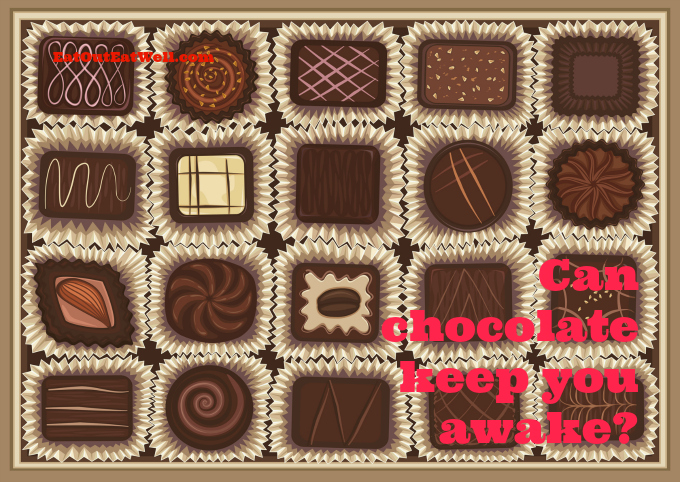Do you hit the chocolate at night, or maybe mid-afternoon? Does your chocolate nibbling follow a chocolate dessert from earlier in the day, or a hot chocolate, or some samples of chocolate candy? And perhaps all of that chocolate indulgence is washed down by a couple (or more) cups of coffee.
It gets to be bedtime and sleep is downright elusive. You wonder why you’re wide awake since you’ve been on the go all day.
Here’s a possibility – your sleeplessness might, in part, be due to all of the caffeine not just in your coffee (or tea) but in your chocolate, too. There isn’t a huge amount of caffeine in chocolate, but perhaps enough – especially if you’re a chocoholic or caffeine sensitive – to help tip the insomnia scales when it’s combined with a day’s worth of other caffeinated food and drinks.
Caffeine and Chocolate
Chocolate – the darker the better – might have some health benefits. But here are a few facts about chocolate that most people don’t know:
- Chocolate contains caffeine, not enough to give you a big time boost, but depending on the type of chocolate, enough to register — especially if you’re working your way through some of those oversized bars or you’re stuffing in a bunch of fun-sized bars or chocolate Easter eggs.
- Usually, the darker the chocolate, the more caffeine it has. Unsweetened or semi-sweetchocolate has about 5-10mg of caffeine per ounce of chocolate. Milk chocolate generally has 5mg or less of caffeine per ounce.
- It would take about 14 regularly sized (1.5 ounce) bars of milk chocolate to give you the same amount of caffeine that you’d get from an 8-ounce cup of coffee. Along with that little caffeine buzz you’d also be shoving in about 3,000 calories and more than 300 grams of sugar. If you’re looking for caffeine, coffee seems like a better bet at about two calories for an 8-ounce cup (black, no sugar).
- Dark chocolate has a higher caffeine content than milk chocolate but it would still take four regular sized bars to get the same amount that you’d find in one cup of black coffee.
Something To Think About
If you have trouble sleeping, along with avoiding coffee before bed, you might want to take note of the amount of chocolate you’re eating.
Something else to think about: getting kids (and some adults) to sleep on Halloween, Easter, and other chocolate heavy holidays might have a whole lot to do with both the sugar and the amount of caffeine in all of the chocolate candy.
The Amount of Caffeine in Beverages and Chocolate
Caffeine In Chocolate
- Hershey’s Milk Chocolate Bar, 1bar/1.55 ounces: 9 mg caffeine
- Hershey’s Special Dark Chocolate Bar, 1 bar/1.45 ounces: 20 mg caffeine
- Hershey’s Kisses, 9 pieces: 9 mg caffeine
- Hershey’s Special Dark Kisses, 9 pieces: 20 mg caffeine
- Scharffen Berger Milk 41% Cacao, ½ bar: 17 mg caffeine
- Scharffen Berger Extra Dark 82% Cacao, ½ bar: 42 mg caffeine
- Dagoba Milk Chocolate 37% Cacao, ½ bar: 9 mg caffeine
- Dagoba Dark Chocolate 73% Cacao, ½ bar: 36 mg caffeine
Caffeine In Coffee
- Coffee, generic brewed, 8 ounces: 133 mg caffeine (range: 102-200; 16 ounces, 266 mg caffeine)
- Dunkin’ Donuts regular coffee, 16 ounces: 206 mg caffeine
- Starbucks Brewed Coffee (Grande), 16 ounces: 320 mg caffeine
- Coffee, generic instant, 8 ounces: 93 mg caffeine (range 27-173)
- Espresso, generic, 1 ounce: 40 mg caffeine (range 30-90)
- Starbucks Espresso, solo, 1 ounce: 75 mg caffeine
- Coffee, generic decaffeinated, 8 ounce: 5 mg caffeine (range 3-12)
Caffeine in Non-Coffee Beverages
- Tea, brewed, 8 ounces: 40 – 60 mg
- Green tea, 8 ounces: 15 mg
- Hot cocoa, 8 ounces: 14 mg caffeine
- Chocolate Milk, 8 ounces: 5 mg caffeine
- Red Bull, 8.2 ounces: 80 mg
- Mountain Dew, 12 ounces: 55 mg caffeine
- Pepsi-Cola, 12 ounces: 37.5 mg caffeine
- Classic Coco Cola, 12 ounces, 34 mg caffeiene
- Snapple flavored tea, 12 ounces: 31.5 mg caffeine
Remember to Like and follow Eat Out Eat Well on Facebook, Twitter, Google+, and Pinterest!


Leave a Reply